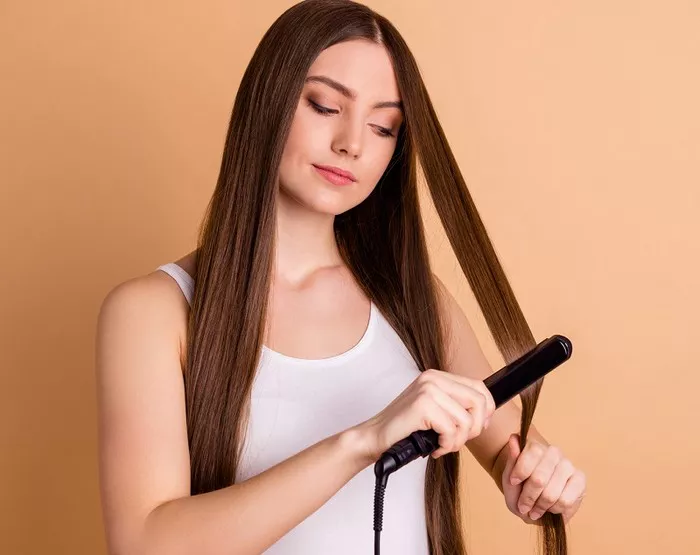Flat ironing wet hair is a common practice for those seeking quick styling solutions, but it comes with significant risks and potential damage. This article delves into the reasons why flat ironing wet hair can be harmful, explores the science behind hair structure, and offers best practices for heat styling to maintain healthy, vibrant hair.
The Science of Hair Structure
Hair Composition
Human hair is primarily composed of keratin, a type of protein, along with water and lipids. Each hair strand consists of three layers: the cuticle, cortex, and medulla. The cuticle is the outermost layer, responsible for protecting the inner layers. The cortex provides strength, color, and texture, while the medulla is the innermost layer, often absent in finer hair.
Hair and Water
Hair’s natural moisture content is around 10-15%. When wet, hair absorbs water, increasing its moisture content and making it more elastic and prone to damage. Wet hair stretches more easily than dry hair, but this flexibility also means it can be more susceptible to breakage and split ends when subjected to mechanical stress.
Why Flat Ironing Wet Hair is Harmful
The Risk of Hair Frying
Flat irons can reach temperatures upwards of 450°F (232°C). Applying such high heat directly to wet hair can cause the water within the hair shaft to rapidly turn into steam. This sudden change from liquid to gas can lead to “hair frying,” where the steam literally cooks the hair from the inside out, causing bubbles to form within the hair shaft. This phenomenon, known as “bubble hair,” weakens the structural integrity of the hair, making it more prone to breakage and split ends.
Cuticle Damage
The cuticle layer, which protects the hair, can be severely damaged when exposed to high heat while wet. Normally, the cuticle scales lie flat, providing a smooth surface that reflects light and gives hair its shine. However, when exposed to excessive heat, especially on wet hair, these scales can lift or break, leading to a rough texture, dull appearance, and increased susceptibility to further damage.
Increased Porosity
Hair porosity refers to the hair’s ability to absorb and retain moisture. Excessive heat styling, particularly on wet hair, can increase hair porosity, causing it to absorb moisture more readily but also lose it just as quickly. High porosity hair tends to be more prone to frizz, tangling, and breakage.
Best Practices for Heat Styling
Always Dry Hair First
The cardinal rule for using any heat styling tool is to ensure your hair is completely dry before starting. Use a towel to blot out excess moisture and then allow your hair to air dry or use a blow dryer on a low heat setting. Ensuring your hair is dry minimizes the risk of steam damage and reduces the likelihood of heat-induced harm.
Use Heat Protectant
Applying a heat protectant spray or serum before heat styling is essential. Heat protectants form a barrier on the hair shaft, reducing moisture loss and protecting the cuticle from heat damage. Look for products that contain silicones like dimethicone or cyclomethicone, which are effective in providing heat protection.
Lower the Temperature
Modern flat irons come with adjustable temperature settings. Use the lowest effective temperature to achieve your desired style. Fine or damaged hair requires lower temperatures (below 300°F or 149°C), while thicker, coarser hair can withstand higher temperatures (up to 400°F or 204°C). Avoid the highest settings unless absolutely necessary, as they increase the risk of damage.
Use Quality Tools
Invest in a high-quality flat iron with ceramic or tourmaline plates. These materials provide even heat distribution and reduce the risk of hot spots that can cause localized damage. Some advanced flat irons also come with ionic technology, which helps to reduce frizz and static.
See Also: Is Hair Loss a Sign of Ovarian Cancer?
Limit Frequency
Limit the frequency of heat styling to reduce cumulative damage. Give your hair regular breaks from heat styling and embrace natural styles when possible. Incorporating heat-free styling techniques, like braiding or using hair rollers, can also help maintain hair health.
Proper Maintenance and Care
Regular trims, deep conditioning treatments, and using sulfate-free shampoos can help maintain the health of heat-styled hair. Trim split ends every 6-8 weeks to prevent further damage from traveling up the hair shaft. Deep conditioning treatments restore moisture and nutrients, keeping hair strong and resilient.
Alternative Styling Methods
Air Drying
Allowing your hair to air dry is the safest method to prevent heat damage. After washing, gently towel-dry your hair and apply a leave-in conditioner or styling cream to enhance your natural texture. This method is particularly beneficial for those with curly or wavy hair, as it helps maintain natural curl patterns.
Blow Drying with a Round Brush
For those who prefer a sleek, straight look, blow drying with a round brush can be an effective alternative to flat ironing. Use a blow dryer with a concentrator nozzle and a round brush to smooth out hair while drying. This method provides volume and smoothness without the high heat of a flat iron.
Heatless Curls
Heatless curling methods, such as using foam rollers, braids, or twist-outs, can create beautiful curls and waves without exposing your hair to heat. These techniques may take longer to set but are much gentler on the hair.
Conclusion
Is it bad to flat iron wet hair? Absolutely.
Flat ironing wet hair poses significant risks, including structural damage, increased porosity, and weakened cuticles. Understanding the science behind hair structure and the impact of heat is crucial for maintaining healthy hair. By following best practices such as drying hair first, using heat protectants, and opting for lower temperatures, you can minimize damage and keep your hair looking its best. Embrace alternative styling methods to reduce reliance on heat tools and prioritize the health of your hair.


